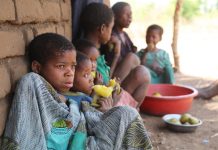“Today, we are calling for us dollars 1.72 billion to continue providing life-saving assistance and protection for six million people in need in South Sudan,” said Alain Noudehou, the Humanitarian Coordinator for South Sudan.
“There is growing need for humanitarian assistance with displacement, food insecurity, malnutrition, violence, and economic decline taking a toll on the health, safety, and livelihoods of people in need.
Since the outbreak in 2013, about 4 million people have been forced to flee their homes, including nearly 1.9 million people who have been internally displaced and about 2.1 million who have fled as refugees to neighboring countries.
In November alone, nine humanitarian workers were killed in November, making it the most dangerous month since December 2013, according to the United Nations Office for Coordination of Humanitarian Affairs (OCHA).
Six security incidents forced the relocation of 47 aid workers and suspension of aid activities in different locations. A total of 103 humanitarian access incidents were reported in November, compared to 116 in October.
As the conflict continues in some parts of the country, rates of hunger and malnutrition have risen, and the food security partners report the risk of famine as significant for thousands of people in multiple areas, if early actions are not taken.
According to the South Sudan Integrated Food Security Phase Classification (IPC), an earlier than normal start of the lean season will result in an estimated 5.1 million people (48per cent of the total population) being classified as severely food insecure between January to March 2018.
According to nutritional surveys, approximately half of all South Sudanese children under five experience acute malnutrition.
As of the end of November, humanitarian organizations reached to more than five million people with assistance and protection since the beginning of the year.
Mr. Noudehou thanked donors who contributed to cover over 70% of the plan for 2017. He also called on the partners to continue supporting the humanitarian situation in South Sudan, so that millions of people are saved from the conflict, displacement, and economic crisis.
“With our collective and coordinated efforts, we will be able to effectively provide much needed assistance to the people in need. Children will remain in schools. Many more will survive diseases. Livelihoods and hope will be restored. There is so much at stake,” said Mr. Noudehou.
One hundred and sixty-seven aid organizations including 95 national and Non-Governmental Organizations (NGOs) sixty one international NGOs and 11 United Nations agencies aim to implement projects under the 2018 Humanitarian Response Plan.
The Minister of Humanitarian Affairs and Disaster Management, Hussein Mar Nyuot said the launch is at a time when the humanitarian situation is deteriorating every day.
“I believe these figures in the New Year will actually increase as you already know of the crises in Jonglei and western lakes and Gok states.
He said the 7 million people in need of humanitarian assistance, and the 5 million targeted for 2018 and the 1.72 billion dollars. I believe if we don’t get that amount and the donors do not respond, more crisis in South Sudan.
“That means 2018 might be worse than 2017 if we take those reports seriously and I believe in those reports,” Minister Nyuot warned.
He said the figures are most likely to increase unless the government and its partners work together to mobilize resources and the donors continue to be generous.
Minister Nyuot said the government is committed in ensuring free access for humanitarian assistance in South Sudan, and that harassment of humanitarian workers and denying them movement is not in the spirit of the order by President Kiir for free access for humanitarian workers.
He said despite the challenges, the aid workers should corporate with the government to work together in order to assist those in need.













